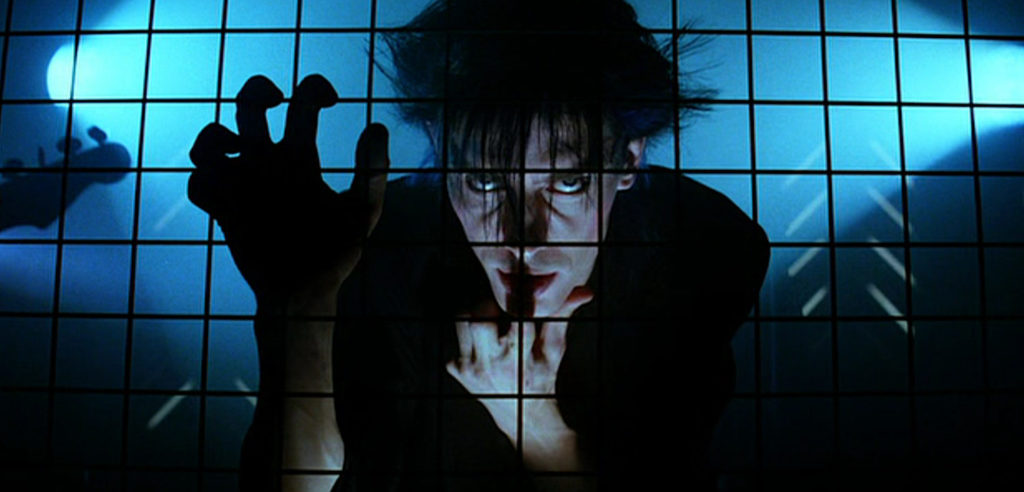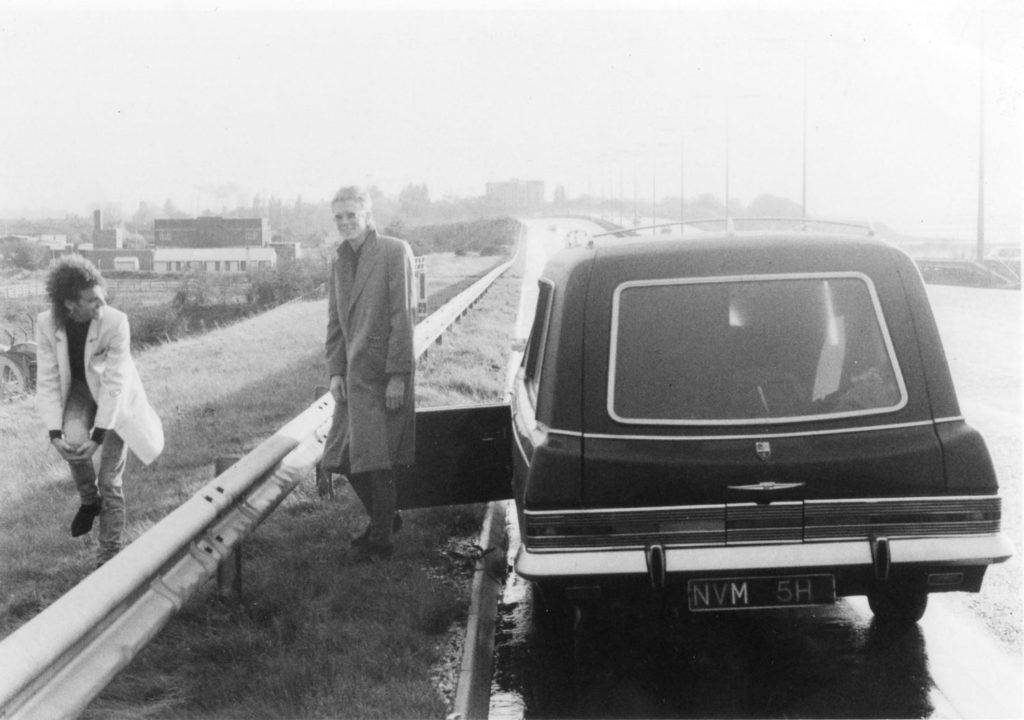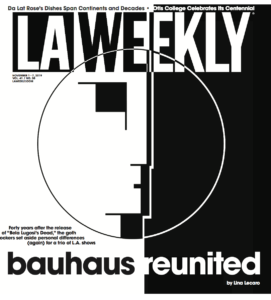“As contradictory as this may seem, Bauhaus being, in my opinion, the Godfathers of Goth: they were a bright artistic light in a vast wasteland of crappy pop darkness. They showed me the way.” —Maynard James Keenan (Tool, Puscifer)
“Bauhaus were complicated, at times earnest, at times distant and ironic, at times delicate, at times vicious …I could never put my finger on them or what they did and that made me love them more.” —Moby
“There’ a particular kind of kismet that rings around Bauhaus’ key covers. Being the cracked and near ruinous descendents in their twin Bowie-Marc-God. For the lads both inherited the dregs of glam and the haunted foreshadowing of goth; and paid in many ways for their prescience. And I as imagined it they were the Spiders if Ziggy had failed but hung on or the Rex if he’d never aged.” —Billy Corgan (The Smashing Pumpkins)
The praise above comes from the foreword of Bauhaus Undead — The Visual History and Legacy of Bauhaus, a stunning, mostly photographic chronicle of the band by its drummer Kevin Haskins published last year by L.A.-based Cleopatra Records. When it came out, Haskins appeared on this writer’s internet radio show to reminisce about the band and share its 40-year journey — from its formation in Northampton, England, in 1978 and the group’s first trip to the U.S. (where Iggy Pop good-naturedly heckled them at a gig) to filming the unforgettable opening scene in the David Bowie/Catherine Deneuve vampire classic The Hunger.
Though he was having fun looking back at Bauhaus via the book, Haskins was playing in another band at the time called Poptone with his daughter Diva Dompé and former Bauhaus guitarist Daniel Ash. Poptone played music from Tones on Tail and Love & Rockets, Ash and Haskins’ subsequent outfits, as well as material from Bauhaus, but it was far from an extensive survey of the original group. As Haskins explained on air, Ash chose only to perform songs he wrote or sang on for the project, which meant that they didn’t play Bauhaus’ most famous track, the one that even to this day defines its gloomy essence. By contrast, singer Peter Murphy, who was touring as a solo artist both before and after Poptone’s formation, has often performed it — indeed, he’s pretty much expected to.

From “The Hunger” (MGM/UA/Kobal/Shutterstock)
“The bats have left the bell tower/ The victims have been bled/ Red velvet lines the black box… Undead undead undead/ Undead undead undead…”
We’re speaking of the hypnotic “Bela Lugosi’s Dead” of course. Arguably the most goth recording of all time, it’s a song that conjures a lot in a fairly simplistic, but undeniably cinematic way. A dramatically descending bassline, piercing guitars and Murphy’s ghoulish yet gorgeous vocals bleed together to create something menacing and altogether magical. The subject matter, which celebrates film’s most famous Dracula by referencing both his death and his transcendent legacy, didn’t hurt its niche appeal either.
With time, “Bela” has become more than a death rock mixtape staple or cob-web clearing dancefloor jam, it is a post-punk masterpiece that’s cleverly self-aware but never crosses into camp. More impressively, it plays with irony, even as it digs its pointy black boots into the deepest, darkest imagery, which made it the perfect song for director Tony Scott to open up The Hunger with. Lugosi the actor had been deceased for many years when the song was recorded, but the power and mystery of his personna was in fact, very undead.
In 2019, the same could be said for Bauhaus itself. Thanks to film score placement (usually creepy fare) as well as a renewed interest in — and respect for — ’80s music and dark aesthetics and fashion, Bauhaus have not only maintained name recognition (arguably surpassing that of the art movement that inspired the moniker) but cultural cachet as well. Like The Misfits and Joy Division, their iconography means almost as much as the music itself. Perhaps more significant than movies or merch, the musicians themselves have not been buried away. Poptone turned in some incredible shows during its run the past couple of years and Peter Murphy toured pretty regularly as a solo artist since the band’s last breakup in 2008, amping things up last year for the band’s 40th anniversary by playing some of their most beloved albums track by track in entirety, accompanied by bassist David J.

Peter Murphy (Tim Norris)
In addition to chatting with Haskins, we’ve interviewed Murphy and J. (Kevin’s brother) a couple of times in recent years for various projects, and each time, when the question of a reunion came up, the answer was a resounding no. (Haskins was a little more open, however, and he even told L.A. Weekly music editor Brett Callwood last year, “I’ve learned to never say never.”)
The band’s first breakup was in 1983. They reformed for their 20th Anniversary in 1998, but it was basically a one-off. They reunited for Coachella in 2005 and turned in a set people still talk about — it opened with Murphy doing Lugosi hanging upside down like a bat and singing the entirety of the 9-minute song that way. They were fiendish and damn near flawless that night, cementing their legacy some might say, with the kind of performance that made Coachella, well, Coachella. As Haskins recounts in his book, Murphy left the stage exclaiming, “Now you can say that you were there!”
After the festival, the band did some touring with Nine Inch Nails and proceeded to put out one of the best records of their career 2008’s Go Away White. But, as J. told us back then, recording it was contentious and they needed space once it was complete — “like continents,” he admitted. So Bauhaus really did go away (ironically-driven as ever, not “in black” as everyone might expect, but “in white”) leaving fans with some bright new numbers and putting old incarnations to rest.

(Kevin Haskins)
Not surprisingly, when Bauhaus announced last month reunion shows at the Palladium in early November, it seemed to come out of nowhere. Fans were rabid and two more dates were quickly added due to the demand. L.A. Weekly reached out to their PR representative right away about interviews, but was told the band would not be giving any. Period. They wanted the music to speak for itself, apparently, and maybe to keep things mysterious. The press release for the shows was brief and the only imagery put out for media and advertising was a slight update of their iconic face logo.
With members staying mum, fans have speculated (of course) on social media about why they are getting back together after 13 years apart, during which the bad blood between them has been fairly well-documented. Is this just a money grab or something deeper, perhaps prompted by Murphy’s recent heart attack (which happened halfway through a retrospective residency at NYC’s Le Poisson Rouge this summer)?
No one can blame the band for not wanting to dredge up the drama of the past either way. In 2013, Murphy was busted for a hit-and-run, suspicion of DUI, and meth possession. It was widely reported that he avoided jail time by pleading guilty to the meth charge and no contest to the hit-and-run, which led to a sentence of three years probation and 45 days of Narcotics Anonymous meetings. In an interview just after the incident, which he didn’t want to discuss, he told us that in spite of how things might have appeared, he was happier than ever playing the old material and especially new stuff off his release on Nettwerk Records called Lion.
The band’s publicist told us of the incident that, “Peter was advised to plead no contest to the meth charge because it led to an exoneration of the charge once he completed community service and AA meetings (not Narcotics Anonymous meetings as was reported). The DUI was dropped because he had zero blood alcohol content. Actually, the entire drug charge was vacated from Peter’s record within a year of the arrest, which was never reported, because it was determined that his rights were violated.”
Indeed, when he performed at the Fonda later that week, he was no worse for wear and he killed it. The show was so good it was made into a live album, Mr. Moonlight Tour: 35 Years of Bauhaus also on Nettwerk.
On subsequent tours, he hasn’t been on his game quite as much, but there were a plethora of positive reviews for the shows he did with J. last year, as well as the shows he did just before the heart attack, which included an epic tribute in San Francisco to Bowie, who’s clearly the crooner’s biggest musical influence.
Speaking of J., he has a brand new record out, which he’s been touring Europe on and he just so happened to be promoting it the past few weeks, doing a few select interviews. During a phoner last week while he was in Portugal, the reunion was off limits for discussion (“I made a blood pact with my brothers and we have decreed not to speak there of the Bauhaus,” he said impishly) but it was nearly impossible not to, as the band’s early work has direct influences and even references to what he’s doing now; he even recorded a track for the new release at the studio where “Bela Lugosi’s Dead” was originally recorded.

Missive To An Angel From The Halls Of Infamy And Allure (Glass Modern Records) is an impressive release and an extremely personal one for J. In fact, he sees it as a culmination of everything he’s created in the past 36 years. With contributions from Anton Newcombe (Brian Jonestown Massacre), Toby Dammit (Nick Cave And The Bad Seeds), Paul Wallfisch (Swans), Sean Eden (Luna), Rose McGowan and Asia Argento, it’s as arty and audacious as the bassist himself.
Off the record, J. did talk about the highly anticipated reunion a bit and the motivations behind it, and while we can’t share what he said exactly, his sincerity and emotion was touching. Despite the band’s ups and downs, there is clearly a deep respect between each member and a history that goes back… way back. Ash met the Haskins brothers when they were wee tykes and Murphy was brought into the mix by Ash to form the band when all were teens.
Of his recent stint playing with Murphy last year, J. did share sincerely, “ I had my problems with Peter and he had his problems with me, but we mended those problems by the end of that tour, and we were great friends again.”
During the chat (read excerpts from the interview concerning J.’s new music on LAWeekly.com next week), J. acknowledged the band’s “volatile chemistry,” likening some of the at-times rocky relationships between band members to familial spats. Perhaps, that is part of what makes Bauhaus who they are, bringing an intensity and nuance to its sound and style, from their beginnings to its end(s). Strong personalities and singular points of view coming together to create are the common thread nearly every legendary band shares, as are break-ups and make-ups. The tension that flows from each might not make things easy in terms of writing and recording material — surely even less so while touring — but when the alchemy is working and the expression is real, the result can be life-affirming for artists and life-defining for the listener. This is why so many of us former “goth” kids, and outsider music nerds in general, are so passionate about Bauhaus.

Poptone (Levan TK)
“They captured the spirit of the unique artists from the ’70s — Brian Eno, Marc Bolan and Velvet Underground…. And they’ve kept it alive for longer than those artists were even able to do,”says Brian Perera of Cleopatra, who put out Haskins’ book and has included Bauhaus tracks on the label’s popular dark music compilations. He sees the band as more than just goth-fathers. “Their audience has grown up so you see all kinds of people at their shows, not just kids wearing black nail polish or black lipstick.”
Martin Mills, of record label Beggars Banquet — who’s also put out Bauhaus material over the years — concurs, pointing to the band’s “startlingly original yet inexpensive theatricality” as an element that made them unique, recalling, “I remember very early on, they played in an abandoned swimming pool in London… the only lighting was a roadie standing directly in front of the stage shining a torchlight vertically upwards into Peter’s face. Brilliant.”
Bauhaus always sought to conjure something more esoteric and enigmatic — “She’s in Parties,” “Dark Entries,” “Kick in the Eye,” “All We Ever Wanted Was Everything,” “Slice of Life,” and even the cover of “Ziggy Stardust” (one of the best cover songs of all time) are all uniquely theirs — dark but never actually depressing; experimental but accessible as well; seductive and sonically sublime, whether referencing horrors, matters of the heart or stuff nobody gets but them. Interpersonal relationships can inform an artist’s music but they don’t necessarily have to. The music and the mystique were always more than enough, and as they rise from their tombs once again, there’s no reason to kill that with too many hows or whys. They’re already undead anyway.
Bauhaus will play the Hollywood Palladium November 3 and 4 and December 1.
**This story was updated on Thursday, October 31.
Advertising disclosure: We may receive compensation for some of the links in our stories. Thank you for supporting LA Weekly and our advertisers.

